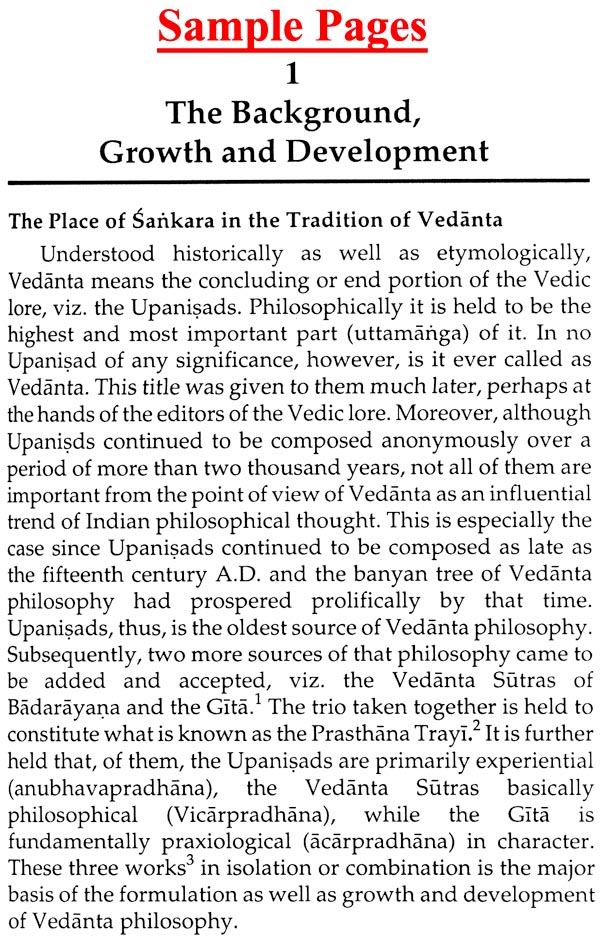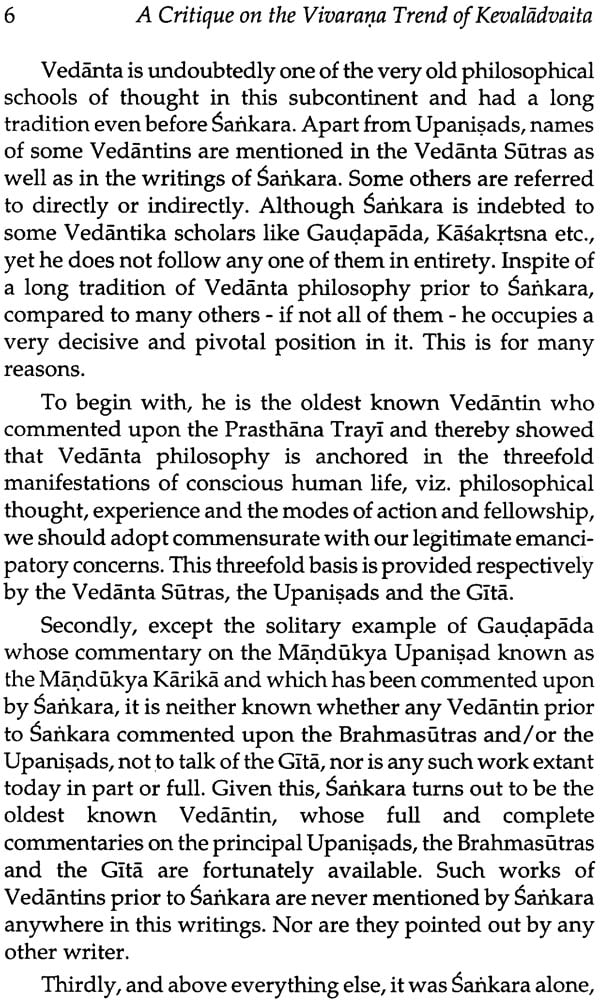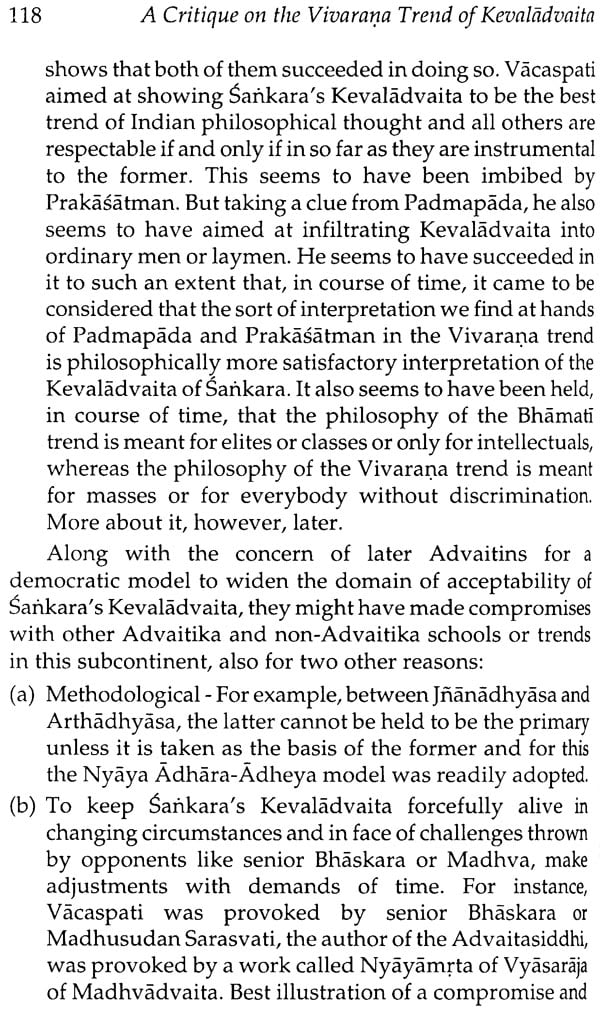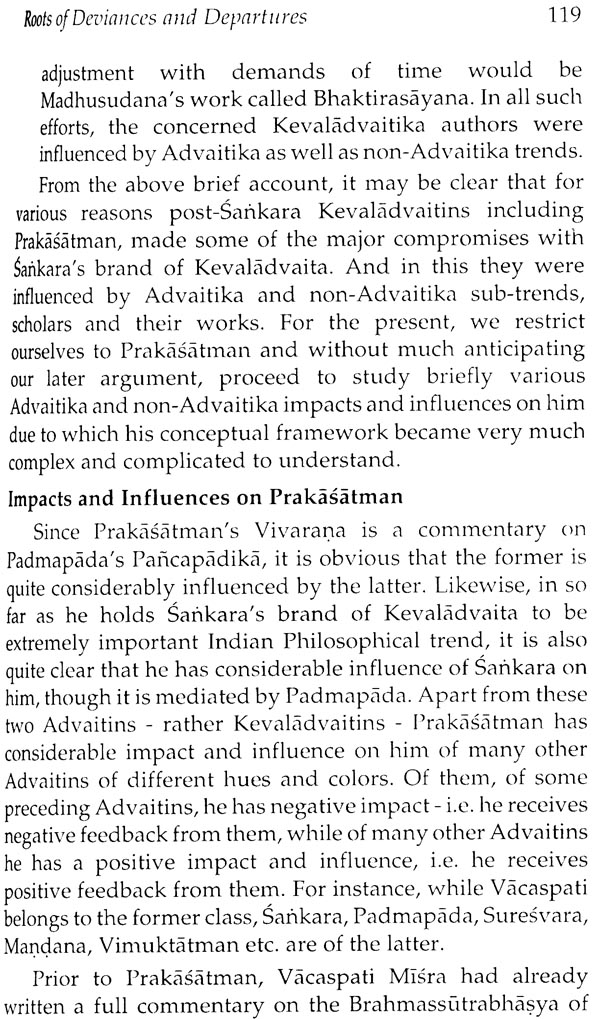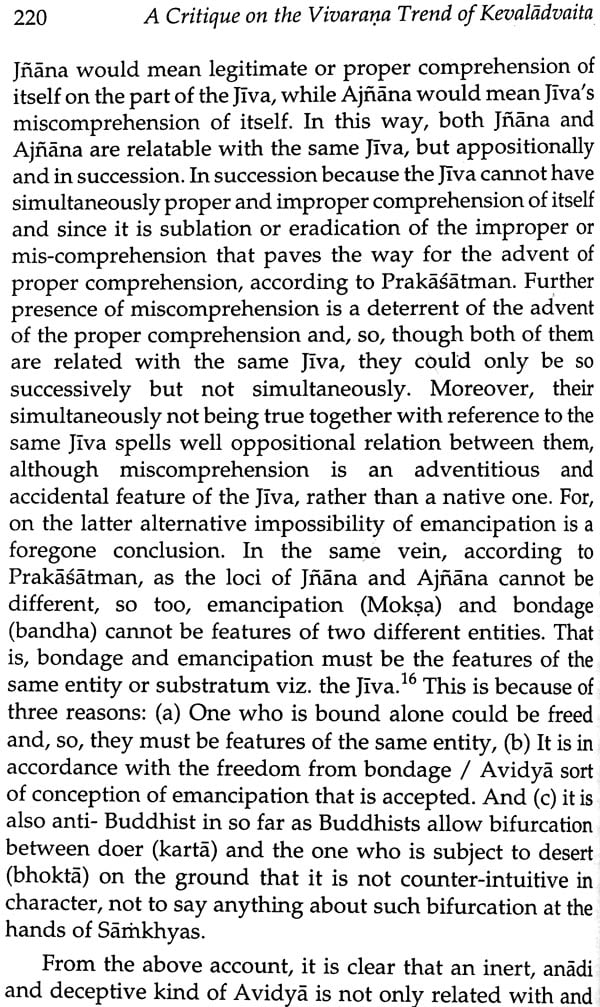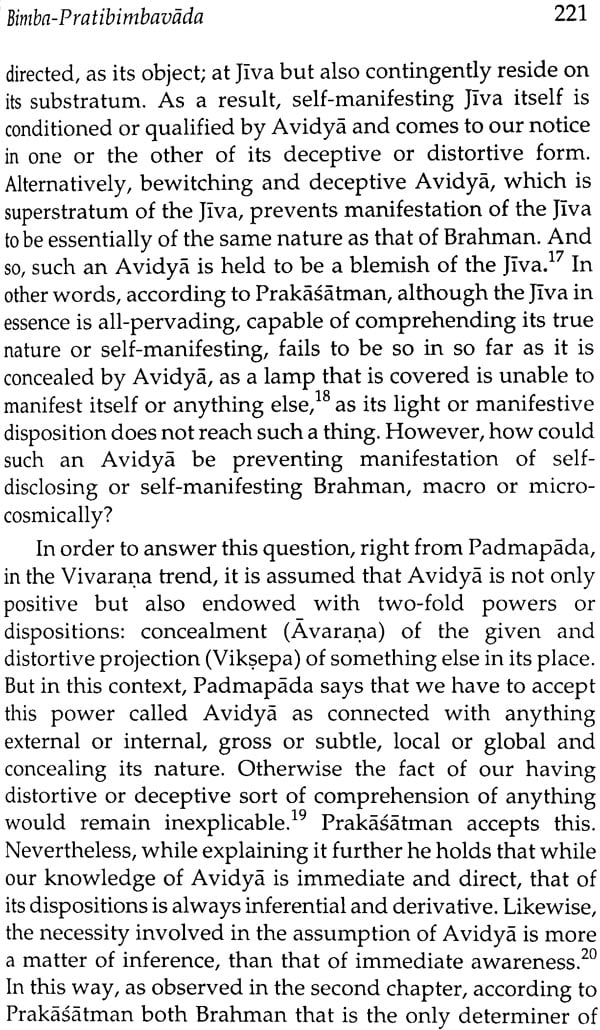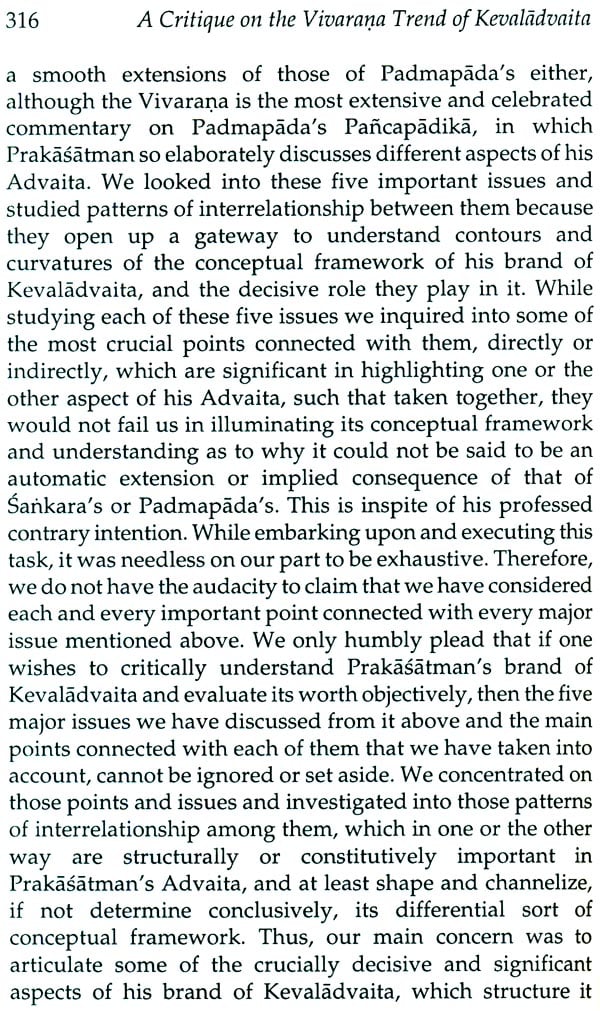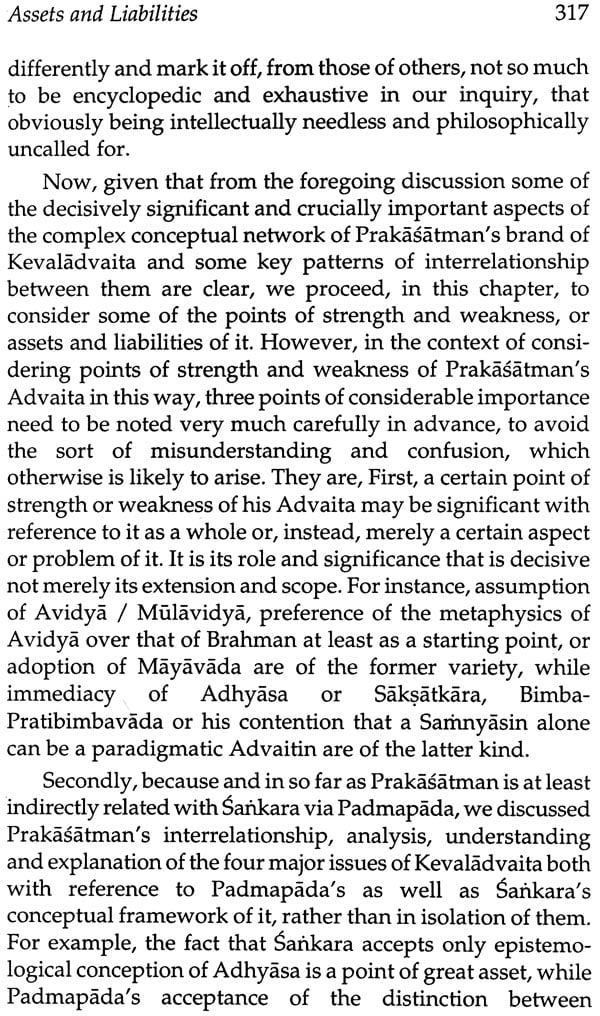
A Critique on The Vivarana Trend of Kevaladvaita (With Special Reference to Padmapada's and Prakasatman's Advaita)
Book Specification
| Item Code: | NAO591 |
| Author: | Dr. Mamata Upagade |
| Publisher: | Bharatiya Kala Prakashan |
| Language: | English |
| Edition: | 2017 |
| ISBN: | 9788180903915 |
| Pages: | 382 |
| Cover: | Hardcover |
| Other Details | 8.5 inch x 5.5 inch |
| Weight | 630 gm |
Book Description
Ignorance of Kevaladvaita of Sankara is profound. In course of time, it came to be highly misinterpreted and gave rise to many misnomers, uninformed and ill- informed accounts and thereby misleading criticism. E.g.,
(a) Sankara's Advaita came to be branded as Mayavada and because of this; it usually comes to be summarized in oft-quoted verse, which runs as follows: "Brahman is the only reality; the world is ultimately false; and the individual soul is non-different from Brahman", although Sankara has never subscribed such a view.
(b) The metaphysics of Brahman at the hands of Sankara came to be substituted by the metaphysics of Avidya.
(c) The world (Iagat) came to be held as completely condemnable and worthless (tuccha) in the tradition of Advaita.
(d) Jivanmukti came to be overshadowed by Videhamukti.
(e) A Samnyasin came to be held to be a paradigmatic Advaitin.
This book is an attempt to find out whether and to what extent, if at all could these views have been anticipated by Sailkara or some kind of extension of his thought and brand of Kevaladvaita together with its conceptual framework. It is also attempted to inquire where the seeds and roots of these views lie and how and why in course of time came to exercise impact upon minds of subsequent scholars and came to be wrongly attributed to Sankaras Advaita.
Dr. Mamata Dattatraya Upagade Date of Birth: 26th June 1970 Academic Qualifications:
M.A., M.Phil,
Ph.D. Deptt. of Philosophy
Rank Holder (B.A., M.A.,
M.Phil level) of the University of Pune. She has been awarded more than dozen prizes including the Dr. Radhakrishnan Prize, Prof. D.D. Wadekar Prize., Prof. Surendra S. Barlingay Prize, The Pracharya Sonopanta Dandekar Prize etc.
Since Sept. 2002 she has been working as Assistant Professor, Deptt. of Philosophy, Govt. Vidarbha Inst. of Science & Humanities, Amaravati.
Besides, she has been actively oarticipating in seminars & Conferences. She has presented about 30 papers in different lnternational, National, State level Regional seminars & conferences. Many of them have been published in well known journals & conference proceedings.
In the Indian sub-continent right from ancient-times Vedas were regarded with highesteem, and what is taught by the so called infallible-Vedas is summarized in the form of various Upanisads by different sages at different times- and-places. We are told that Upanisads were getting composed for approximately about 2500 years (till 15th Cen. A.D.), hence not all of them are so ancient and purporting the exact Summary of the Vedic-lore. Upanisads, it is believed, form the last/ end-part of the Vedas, and it is held that only some (eleven) of the principle Upanisads are authentic and authoritative-representatives of those concluding-thoughts. In course of time, what is being survived, practiced, and thought about the truth in terms of oneself, others -both living and non-living - and the world- at-large is systematized in a condensed-form and preserved in the form of Sutras (form of literature) by all the traditions - of living and (philosophical) thinking. It is believed, thus, that all the Indian philosophical and/ or cultural traditions have roots in the Vedas and/or Upanisads - to which Vedanta is not an exception.
Vedanta-Sutras or Brahma-Sutras of Badarayana purport philosophical-thoughts of the Upanisads: whereas Brahmanas (form of literature) concentrate on the modes of actions / practices of the Vedic-lore, stating the ultimate truth of life and the world. As is well-known Vedanta-Sutras, thus, are connected to Vedas derivatively on the one hand and Upanisads directly on the other; where Brahman - the ultimate truth is one-and-only - is principally highlighted upon, and that's why also known-as the Brahma-Sutras. When one considers the basic-foundations of Vedanta, traditionally we are told that Upanisads (are Anubhava- Pradhana - primacy of experience), Brahma-Sutras (are Vicara Pradhana - primacy of philosophical-thoughts) and GTta (is Acara-Pradhan - primacy of action) - synthesis of this trio - forms the Prasthana-trayi. These three-works, in- isolation and/or in permutation and combination, form the strong-basis of Vedanta. That means Gita, which is a part of well-known Epic Mahabharata, too is fundamentally- important for the Advaita-Vedanta tradition in-general and Kevaladvaita-tradition in-particular. This becomes emphatically-clear only when we turn to Sankara's philosophy, as he has written Bhasyas (commentaries) on all the three corner-stones/ starting-points, i.e. Prasthana- trayi, viz. Upanisads, Gita and Brahma-Sutras, of the Vedanta. That's why while commenting and interpreting the conceptual-thoughts of all the three foundational-works, Sankara not only keeps the three essentially-related with one- another, but also keeps them equi-distant from each-other. He, in his Brahma-Sutra-Bhasya especially, emphasizes on the concept of one-and-only ultimate-truth - the Brahman. For him, Jiva (self) and/or Jagat (world) are ultimately nothing else but Brahman (i.e. Advaita), and it is because of which this tradition is known as Kevaladvaita-tradition of Advaita-Vedanta. And so-long-as we don't realize this and come under the spell of Avidya; we cannot attain Moksa (emancipation). It is because of Avidya we misunderstand and erroneously hold duality of the truth, and differentiate in-between not only ourselves - human-world and/ or living- world - but also the World-at-large; and such Adhyasa segregates and deviates us from the truth giving rise to Duhkha (pain and suffering) in life. Once we free ourselves from the clutches of miscomprehensions (Avidya/Maya), we dissolve our identities automatically and simultaneously merge into Brahman, or anything and everything in the world - living as well as non-living' and of the world' (Advaita). Living with awareness of such identity-less-ness consciously and with conscience is the being' and becoming Brahmibhutatva, which is the ideal-form of life and goal of life according to Sankara's Kevaladvaita. It is this ideal-form of life to be cherished by anyone-and-everyone, and can be attained in this life and in this world only. Whether to start from oneself (Iiva) or from the cosmos (Iagat), and further whether to realize facts of life (i.e. Duhkha) first, or else to hold primacy of understanding the ideals of life (emancipation) determines the difference between Buddhism and Vedanta. That's why Vedanta tradition holds Sankara to be crypto-Buddhist.
Further, on this background, when we consider the followers of Sankara or post-Sankara development of Kevaladvaita-tradition, it is surprising to note that Sankara is truthfully and openly declared to be the authentic-master by one-and-all verbally. But while interpreting the thoughts of Sankara either one or two works of the Prasthana-trayi, in various permutations and combinations, are seen to be either relegated altogether or else given secondary-position. Rather, what we reveal is preserving one's own independence and originality in contribution to the Kevaladvaita-tradition by the followers of Sankara. The reason might be that the socio- cultural and/or intellectual context-prevailed at that time demanded such a move to preserve consistency between life - experiences, modes of actions and practices - on the one hand and thoughts on the other. It may be either because of opposition-within' the tradition itself some erroneous, self- comprehension of the tradition; or else even it may be against the opposition from out-side' followers of the other tradition such demand predominated. And to keep pace with the context in which they were confronting and responding to the situations-prevailed it was essential, or it may be to bridge-up the gap and prove similarity with others to Sustain and calm-down opponents - knowingly or unknowingly - this might have happened. To accommodate changes and modifications, alternative-interpretations and reinter- pretations - rightly or wrongly - of the tradition and thoughts available in the form of texts, in the post-Sankara development of Kevaladvaita-tradition at the hands of later followers is seen. To such a move neither Padmapada nor Prakasatman is an exception.
Sankara's Kevaladvaita afterwards split-into two sects/ trends, Bhamati-Prasthana of Vacaspati Misra based on his Bhamati and Vivarana-Prasthana, seeds of which were sown by Padrnapada's Padcapadika, and hence he is accredited as the founder of the Viva ran a, but as a matter of fact it is due to his indirect disciple Prakasatman, who later on wrote a commentary called Padcapadika-Vivarana and popularized the trend under consideration. Both these trends, i.e. Bhamati-Prasthana and Vivarana-Prasthana, claim that they are the authentic and reliable interpretations of the Brahma- Siitra-Bhasya of Sankara. Although it is interesting and important to study the entire Kevaladvaita tradition of Vedanta starting from Caudapada himself, the authoress has restricted her critique only to the Padmapada's and Prakasatman's Advaita, in the Vivarana-trend, and neither pre-Sankara nor post-Sankara Kevaladvaita inquiry is undertaken of each and every follower to make it sharp and focused properly. A reason to restrict the scope of present work is made clear in the respective introductions of part one and two of this book. Similarly, she restrictively focuses on only two, Padmapada and his follower Prakasatman, forming foundations of the Vivarana-trend, and not their further followers from Vivarana-trend of Kevaladvaita too are not considered is emphatically made clear by her.
It gives me immense pleasure to present this book, in two parts on the Vivarana Prasthana of Kevaladvaita. Kevaladvaita is one of the most influential and widespread schools of philosophical thought in this subcontinent, the subsequent growth and development of which is found with two hefty and widespread branches of it. First, the Vivarana Prasthana pioneered by Padrnapada and further developed more vigorously by Prakasatman, Second, the Bhamati Prasthana pioneered by Vacaspati. Both these trends have a prolonged tradition and with each of them, we find a fundamental sort of conceptual change. Such a vast and varied development cannot be treated adequately in a brief work like this. Therefore, the present work is restricted only to the two prominent or eminent figures in the Advaita Vedanta in general and the Vivarana Prasthana in particular viz. Padrnapada and Prakasatman, although it is interesting to look into the further conceptual growth and development of the same beyond Prakasatman. To put more precisely, the first part of the present work is devoted to Padmapada while in the second part I have concentrated on Prakasatman's conceptual framework of Kevaladvaita. My main objective in this work has been to give though not comprehensive but clear and critical account of Padmapada and Prakasatman's conceptual framework of Kevaladvaita. I am interested in finding out the nature, function, the catalytic value, the place and relevance of Padrnapada's Pancapadika and Prakasatman's Paficapadika-Vivarana That is, I wish to study the texts under consideration in their proper philosophical context and thereby the conceptual change, growth and development of Kevaladvaita thought in general. Thus, my inquiry into the conceptual framework of Padmapada and Prakasatman's brand of Kevaladvaita is neither merely historical nor descriptive but analytic, critical and evaluative in character.
Along with this, Kevaladvaita engaged my attention quite seriously and overwhelmingly at least for two following reasons. First, it uncompromisingly accepts and advocates the conception of unity both on microcosmic as well as macrocosmic level, which is significant and very much useful in the modern era of globalization. Second, Ignorance of Indian philosophy in general and Kevaladvaita of Sankara in particular is profound. Some of its doctrines although wrongly attributed to Sankara are seen to be deeply rooted even today, in our day-to-day life. That is, Kevaladvaita of Sankara, in course of time, came to be highly misinterpreted and gave rise to many misnomers, uninformed and ill-informed accounts and thereby misleading criticism. Few of them can be mentioned here. (a) Sankara's Advaita came to be branded as Mayavada and because of this; it usually comes to be summarized in oft-quoted verse, which runs as follows: "Brahman is the only reality; the world is ultimately false; and the individual soul is non-different from Brahman," although Sankara has never subscribed such a view.
(b) The metaphysics of Brahman at the hands of Sankara came to be substituted by the metaphysics of Avidya.
(c) The world (Jagat) came to be held as completely condemnable and worthless (tuccha) in the tradition of Advaita.
(d) Jivanmukti came to be overshadowed by Videhamukti.
(e) A Samnyasin came to be held to be a paradigmatic Advaitin.
This book is an attempt to find out whether and to what extent, if at all could these views have been anticipated by Sankara or some kind of extension of his thought and brand of Kevaladvaita together with its conceptual framework. Moreover, it is attempted to inquire where the seeds and roots of these views lie and how and why in course of time came to exercise impact upon minds of subsequent scholars and came to be wrongly attributed to Sankara's Advaita. I shall feel amply rewarded if at all at least to certain extent I succeed in removing such misconceptions and arouse a genuine interest in Kevaladvaita, in the mind of interested readers, which has been one of my objectives.
The present work is based on my study of the original sources. Therefore, I have either quoted from the original texts or referred to them on almost all fundamental points to enable the interested readers to compare.
Before concluding, it would be a matter of ungrateful on my part, if I do not acknowledge my indebtedness to all those, who helped me on various counts during the entire course of this work.
First, I express my deep and sincere feeling of gratitude to Late Prof. Marathe formerly the head of the department of Philosophy, University of Pune, although any word of acknowledgement, I feel are simply inadequate to express the said feeling. I have been privileged to receive his unfailing and inspiring encouragement and co-operation. Moreover, his sustained and valuable suggestions during repeated and prol nged discussions I had with him, right from the beginning of the present work, not only enabled me to free myself from the various above said misunderstandings and misconceptions but also developed my interest and gave me a proper direction and perspective to work on this area of investigation.
Advaita Vedanta, no doubt is one of the important and predominant schools in Indian philosophical tradition. Sankaracarya is said to be the first systematizer of this school of thought. His teaching is presented through his commentaries on the principal Upanisads, the Brahmasutra's of Badarayana and the Gita.
If we look into the growth and development of the Advaita school, we notice that in course of time, Sankara's original teaching came to be interpreted differently by two different scholars one by Padmapada and another by Vacaspati Misra. With this they came to pioneer two additional trends in the house of Advaita itself. As it is accepted by the tradition itself, that there are three major trends in Advaita Vedanta in general. They are:
(1) The Bhasyaprasthana advocated by Sankaracarya.
(2) The Vivaranaprasthana advocated jointly by Padmapada and Prakasa tman.
(3) The Bhamatiprasthana advocated by Vacaspati Misra.
Comprehensive study of Advaita Vedanta in general is not possible without taking into consideration the three brands of it. However, here as far as the scope and limitations of the first part of the present work is concerned I intend to concentrate only on the Padmapada's brand of Advaita. As far as the Vivaranaprasthana in general is concerned, Padmapada is traditionally said to be the founder of it. His well-known book viz. Pancapadika is considered as the basic text of this school of thought. Later on, at the hands of Prakasatman, this school is furthered more explicitly in a profound way. This work of Prakasatman was further commentated upon by Citsukha in his Tatparyadipika and by Nrsimhasrama in his Bhavaprakasika, Again, there are two more commentaries on Padrnapada's Paficapadika viz.
(1) a commentary by Atmasvarirpa in his Prabodha- parisodhini and (2) by Vijnanatman in his Tatparyartha- dyotini. In this way, this particular brand of Advaita viz. Vivaranaprasthana advocated by Padmapada and furthered by Prakasatman got an independent place in the entire tradition of the Advaita school of thought.
Full- fledged comprehension of the Vivarana school in particular and the line of its development is not possible unless we take into account the entire tradition starting from the Pancapadika. However, as stated above I restrict myself only to an inquiry into the Advaita of Padmapada to see to what extent, if at all, it is an extension of Sankara's Advaita, as Padmapada's Pancapadipika is considered by the tradition as the basic text of the Vivaranaprasthana. Moreover, since it is in this work that the seeds of the trend under consideration are sown; it is all the more necessary to study it carefully. Apart from Pancapadika a few more works are also ascribed to Padmapada. They are Atmabodhavyakhyana, Vijnanadipika and Ahankartika, Of them, Padmapada explicitly refers to the last in the Paficapadika.' However, since none of them is extant we have unfortunately to make do only with Pancapadika. According to the tradition, Padmapada was a direct disciple of Sankaracarya. He was in charge of one of the four centers (Mathas) established by Sankara in his very short life-span. Padmapada's well known work called Pancapadika, although incomplete is perhaps the first commentary on Sankara's Brahmasutrabhasya. The extant commentary is only on the first four sutras of the Brahmasutrabhasya of Sankara and is known as Tika.
| Foreword | ix |
| Preface | xv |
|
|
|
| Introduction | 1 |
| 5 | |
| 28 | |
| 51 | |
| 70 | |
| 85 | |
| Introduction | 105 |
| 115 | |
| 125 | |
| 159 | |
| 208 | |
| 266 | |
| 350 | |
| Bibliography | 357 |
| Index | 357 |
